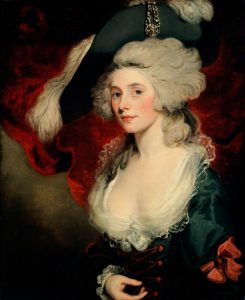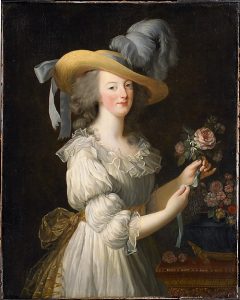
Figure 1. John Hoppner, Mary Robinson as Perdita (1782), Chawton House Library.
Sean John, DASH, Material Girl, William Rast, OVO, House of Harlow, Yeezy, Paper Crown, the Jessica Simpson Collection, Rocawear, The Row, Twenty8Twelve. Celebrity fashion labels are flooding the marketplace, and the phenomenon shows no sign of stopping. Rihanna recently announced a collaboration with Chopard for a joint collection of jewelry, combining “urban chic and classic glamour.”[1] And this coming October, Sarah Jessica Parker will launch her new SJP footwear collection on the Internet behemoth Amazon, featuring the exclusive designs “Dash,” “Flirt,” and “Wink.”[2] InStyle.co.uk broadcasted the affair with the texty title “OMG! Soon You’ll Be Able to Shop SJP’s Shoes On Amazon.”
Not everyone, however, is a fan of the pop-up celebrity designer. Upon receiving the Couture Council’s Award for Artistry in 2012, the late Oscar de la Renta spoke out against the trend: “Today, if you play tennis, you can be a really good designer,” he said, “Or, if you’re an actress, you can be a designer. I’ve been at it for 45 years and I’m still learning my craft.”[3] In addition to suggesting that upstarts are infiltrating the fashion world, de la Renta’s statement imagines a time—his time—when the art of fashion recognized quality design that bespoke training, skill, and experience, rather than sheer fame.
Elegiac musings may have their appeal, but do they reflect reality? There’s no question that celebrity style has long had an impact on the fashion world—think Beau Brummell, Lillie Langtry, Jean Harlow, Katherine Hepburn. The question is how new is the celebrity-cum-couturier? The life of the British actress Mary Robinson (1757?-1800) (Figure 1) would suggest that celebrity clothing and accessory lines are, in fact, nothing new.
Mary Robinson’s meteoric rise to fame began in 1776 with her dazzling performance on the London stage as Juliet, and in 1779 with her spirited rendering of Perdita in David Garrick’s adaptation of Shakespeare’s The Winter’s Tale. The latter representation captivated the Prince of Wales (the future George IV), and an infamous romance between the newly styled “Perdita” and “Florizel” ensued.
Like many starlets today, her love life became a source of scandal and intrigue. When the Prince’s affection waned, Robinson left the stage and travelled to France. She befriended Marie Antoinette and was courted by the wealthiest man in Europe, the Duke de Chartres. In 1782, after her return from the Continent, Robinson indulged in romances with the dashing young dragoon Colonel Banastre Tarleton, a leading commander of British troops in the war against the American colonies, and Charles James Fox, the charismatic leader of the Whig party.
Robinson’s stage career, though brief (she retired from the boards at the close of the 1779-1780 season), was a tour de force. Her performances—both as an actress and a mistress—earned her widespread acclaim and notoriety. In the manner of magazines such as Hello! or People, the newspapers reported continually on her whereabouts. And while paparazzi did not yet exist, painters did. Top artists of the day, Thomas Gainsborough, John Hoppner, Joshua Reynolds, and George Romney, all painted portraits of her.
Robinson’s acting and amours sparked her popularity, but it was her fashion sense and style that kept the flame ablaze. By decorating herself in stunning confections known as the “Perdita Hood,” the “Robinson hat for Ranelagh,” the “Perdita handkerchief,” and the “Robinson gown,” she transformed herself into one of the foremost fashion icons of her day and sent the stylish set into a frenzy.[4]
Her most voguish look was the 1782 “Perdita chemise,” a hoop-free muslin tube cinched at the waist and styled after Marie Antoinette’s version of the gown: the Chémise à la Reine (Figure 2). This design—later promoted in England in a different form by the Duchess of Devonshire (remember Keira Knightley in The Duchess?)—paved the way for the neoclassical gowns of the 1790s and early 1800s. According to one London newspaper, Robinson’s trend-setting styles “set the whole world ‘a madding.’”[5] Women eager to appear à la mode began adorning themselves in her sartorial creations.

Figure 2. Élisabeth Vigée Le Brun, Marie Antoinette in a Chemise Dress (1783), Hessische Hausstiftung [The Hessian House Foundation], Kronberg.
Unlike modern celebrities, Robinson did not profit financially from her designs. Yet her savvy marketing of them ensured her decisive impact on contemporary couture. Robinson made her mark in other artistic circles as well, becoming one of the top authors of her day—a playwright, a novelist, and a poet. Samuel Taylor Coleridge deemed her a woman of “undoubted Genius.”[6] Ultimately, Robinson ensured her legacy in the world of fashion and in the world of letters. Victoria Beckham—eat your heart out.
[1] Erica Gonzales, “Rihanna is Designing a New Jewelry Collection,” Bazaar (7 April 2017) http://www.harpersbazaar.com/fashion/designers/news/a21876/rihanna-collaborates-with-chopard/
[2] Chloe Mac Donnell, “OMG! Soon You’ll Be Able to Shop SJP’s Shoes On Amazon,” InStyle.co.uk (18 July 2017) http://www.instyle.co.uk/news/youll-soon-be-able-shop-sjps-shoe-collection-amazon-fashion#9ClsHusWo6Kqg9iC.99
[3] Ella Alexander, “Oscar de la Renta Honored,” Vogue (6 Sept. 2012) http://www.vogue.co.uk/article/oscar-de-la-renta-receives-couture-council-artistry-award
[4] The Lady’s Magazine began reporting on Robinson in 1780 and continued throughout the decade. For coverage of Robinson’s fashions during the 1782-1783 season, see the Lady’s Magazine, or Entertaining Companion for the Fair Sex 14 (1783): 187, 268, 331, 650-651.
[5] Morning Herald (17 December 1781), p. 2. Additionally, on 15 October 1782, the Morning Herald reported, “An amateur of the Cyprian Corps recommends to our fair countrywomen a total abolition of the large hoop and long petticoat, and to adopt the PERDITA, a system of elegant simplicity and neatness, which has ever so conspicuously marked the dress of that celebrated leader of the wantons of the age!”. Just one month later, the same newspaper was predicting the pervasiveness of Robinson’s fashion trend: “The Chemise de la Reine, in which Mrs Robinson appeared at the Opera, is expected to become a favourite undress among the fashionable women” (Morning Herald, 20 November 1782). Georgiana, the Duchess of Devonshire was also instrumental in popularizing the chemise in England. In 1784, she reported having gone “to a concert in one of the muslin chemises with fine lace that the Queen of France gave me”; qtd. Georgiana: Extracts from the Correspondence of Georgiana, Duchess of Devonshire, ed. Earl of Bessborough (London, 1955), 91. In 1786, Angelica Kauffman painted Lady Elizabeth Foster, a close friend of the Duchess, in a version of the chemise with a double falling collar. By 1787 the Lady’s Magazine reported that “all the Sex now . . . appear in their white muslin frocks with broad sashes”; see the Lady’s Magazine (London, 1787), 331.
[6] Samuel Taylor Coleridge to Robert Southey (25 Jan. 1800), The Collected Letters of Samuel Taylor Coleridge. Ed. Earl Leslie Griggs. 6 vols. (Oxford: Clarendon Press, 1956). 1: 562-564.
